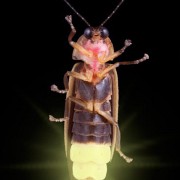 Photo: Getty Images
Photo: Getty Images
Here’s a riddle for you: What do fireflies and tracking cancerous tumors have in common?
The answer is luciferase. That’s right, the same enzyme that gives fireflies their intriguing glow is being tested by Berkeley Laboratory researchers to monitor the progression of cancerous tumors or infectious diseases in mice without harming the animal—or even having to shave their fur.
Right now you might be thinking, “Wow, this sounds really sci-fi,” but rest assured it’s real and though the research is complicated, the idea behind it is relatively simple and offers real life benefits. In the future, cancer patients, for instance, may be able to have their disease monitored in real time without having to undergo a biopsy or other surgical procedure.
Christopher Chang, a chemist who holds appointments with Berkeley Lab’s Chemical Sciences Division and UC Berkeley’s Chemistry Department, as well as the Howard Hughes Medical Institute, said “in vivo imaging” affords a unique technology for monitoring real time physiological fluctuations in hydrogen peroxide levels. (In vivo is the latin word meaning “within the living”).
“This offers opportunities to dissect the disparate contributions of hydrogen peroxide to health, aging and disease,” the researcher said.
You know hydrogen peroxide as nature’s disinfectant. Hydrogen peroxide is produced within our cells as a small, but highly reactive molecule to kill invading pathogens. It also plays a critical role in cellular signaling that is essential to the growth, development and physical well being of humans and other organisms.
However, if hydrogen peroxide is being over-produced in cells, that’s a cue oxidative stress and inflammation are likely occurring. These signals are linked to the onset and progression of cancer, diabetes, and numerous cardiovascular and neurodegenerative diseases. So it makes perfect sense that by tracking hydrogen production, researchers should be able to observe changes in tumor progression and other diseases.
To see changes in an organism’s hydrogen peroxide level, the researchers turned to the clever firefly. The insect’s bioluminescence offered scientists a non-evasive way to monitor disease progression.
Since mice don’t naturally glow, Chang and colleagues knew they would have to create a probe that could carry the luciferin in vivo. Keep in mind, the researchers had very specific goals: They wanted a probe that could simultaneously detect hydrogen peroxide signals from multiple regions or the entire organism and they wanted to track intracellular signals within specific tissue, preferably without having to remove skin or fur to do so.
Chang and colleagues created the PCL-1 probe, a light-emitting luciferin molecule enclosed inside a molecular cage of boronic acid. In research, boronic acid is often used as a chemical building block. In this case, its purpose is to selectively react with hydrogen peroxide molecules to release the luciferin triggering the bioluminescent glow. For their studies, the researchers worked with transgenic mice that carried the firefly luciferase gene.
The PCL-1 probe allowed them to study mice with prostate cancers and monitor fluctuations in the hydrogen peroxide generated by cancerous cells based on the amount of light emitted by the probe.
“The PCL-1 probe enables us to study the chemistry in living animals as cancers and other diseases progress,” Chang said. “We can use the probe to look at the same mouse over time to see how see how therapeutics and other treatments affect its physiology, without having to do biopsies or sacrifice the animal. This is a significant advance over previous hydrogen peroxide probes.”
Chang and his colleagues are now working to improve the sensitivity of the PCL-1 probe. They would also like to refine their methodology to be able to simultaneously examine multiple biomarkers.
The research is described in Proceedings of the National Academy of Science (PNAS) and was supported in part by the National Institute of General Medical Sciences in the National Institutes of Health.
Lynette Summerill is an award-winning writer who lives in Scottsdale, Arizona. In addition to writing about cancer-related issues for EmpowHER, she pens Nonsmoking Nation, a blog following global tobacco news and events.





Add a CommentComments
There are no comments yet. Be the first one and get the conversation started!